-
The bank statement and cashbook balances should agree, but sometimes these balances may not agree:
Required:
Discuss this statement and explain why it is important to prepare...
(Solved)
The bank statement and cashbook balances should agree, but sometimes these balances may not agree:
Required:
Discuss this statement and explain why it is important to prepare a bank reconciliation statement.
Date posted:
November 19, 2018
.
Answers (1)
-
The book keeper of Bidii Ltd. prepared the following trial balance as at 31 December 2003:
(Solved)
The book keeper of Bidii Ltd. prepared the following trial balance as at 31 December 2003:
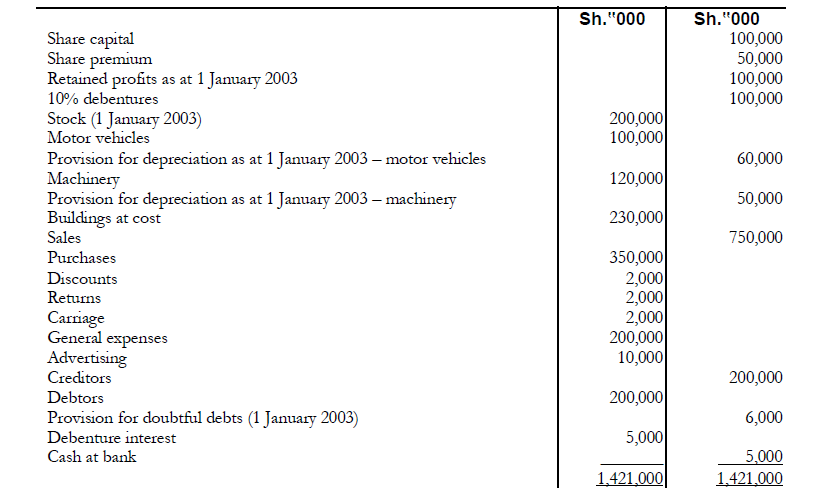
Additional information:
1. In an effort to simplify the accounting process, the book keeper posted both discounts
received and discounts allowed to the discounts account. He has also posted both
returns inwards and returns outwards to the returns accounts, and both carriage inwards
and carriage outwards to the carriage account. Discounts received, returns outwards and
carriage outwards were as follows:
Sh.
Discounts received 1,000,000
Returns outwards 1,000,000
Carriage outwards 1,000,000
2. The following items are already included in general expenses:
- Rates for the 12 months to 31 March 2004, Sh.4,000,000
- Insurance for the 12 months to 31 December 2003 amounted to Sh.2,000,000.
Half of this amount relates to the managing director‟s private expenses.
3. Accountancy fees of Sh.1,000,000 should be provided for
4. A debtor for Sh.20,000,000 has been declared bankrupt. The provision for doubtful
debts is to be made at 5% of the debtors.
5. Dividends of Sh.10,000,000 have been proposed by the board of directors.
6. Stock as at 31 December 2003 is valued at Sh.180,000,000
7. Depreciation of Sh.20,000,000 is to be provided on the motor vehicles and
Sh.10,000,000 on the machinery. The buildings are to be revalued upwards by
Sh.30,000,000
Required:
(a) Trading and profit and loss and appropriation accounts for the year ended 31 December
2003.
(b) Balance sheet as at 31 December 2003
Date posted:
November 17, 2018
.
Answers (1)
-
Kalamu and Karatasi have been trading in partnership for several years, sharing profits and
losses equally after allowing interest on their capitals at the rate of...
(Solved)
Kalamu and Karatasi have been trading in partnership for several years, sharing profits and
losses equally after allowing interest on their capitals at the rate of 8% per annum. On 1
September 2003, the manager of their business, Barua, was admitted as a partner and was to
share one fifth of the profits after interest on capital Kalamu and Karatasi were to share the
balance of the profits equally but guaranteed that Barua‟s share would not fall below
Sh.600,000 per annum.
Barua was not required to introduce any capital at the date of admission but agreed to retain
Sh.150,000 of his profit share at the end of each financial year to be credited to his capital
account until the balance reached Sh.750,000. Until that time, no interest was to be allowed on
his capital.
Goodwill was agreed at Sh.1,500,000 at 1 September 2003, but was not to be maintained in the
accounts. Land and buildings were professionally valued at Sh.2,840,000 on the same date while
the book value of equipment and motor vehicles was to be reduced to Sh.1,500,000 as at that
date.
Barua was previously entitled to a bonus of 5% of the gross profit. This bonus was payable half yearly.
The manager's bonus and the manager's salary were to cease when he became a partner.
The trial balance below was extracted as at 31 December 2003. No adjustments had yet been
made in respect of Barua's admission and the amount he introduced as his
contribution for goodwill had been posted to his current account. The drawings of all the
partners had been charged to their current accounts.
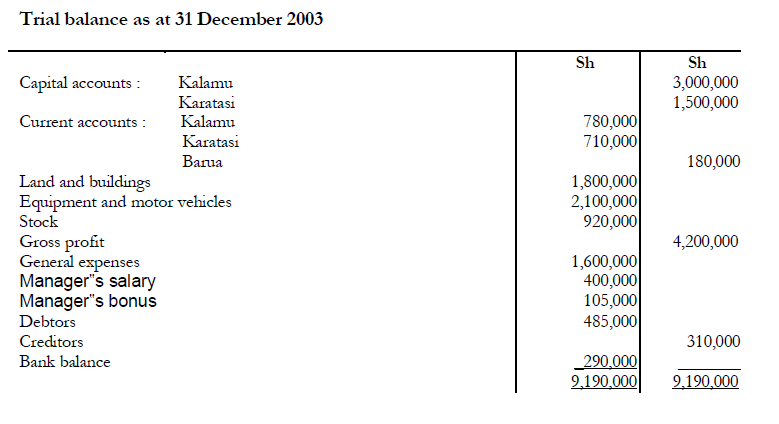
Additional information:
1. It is assumed that gross profit and general expenses accrued evenly throughout the year
except that Sh.100,000 of the general expenses relate to a bad debt that arose in the period
after Barua‟s admission. The balance of the general expenses accrued evenly.
2. Depreciation is to be charged on equipment and motor vehicles at the rate of 20% per
annum on the book value. No depreciation is to be charged on land and buildings.
Required:
(a) Profit and loss account for the year ended 31 December 2003
(b) Partner‟s capital accounts as at 31 December 2003.
(c) Partner‟s current accounts as at 31 December 2003.
Date posted:
November 17, 2018
.
Answers (1)
-
The trial balance of Amanda Ltd as at 30 April 2004 did not balance. On investigation, the
following errors were discovered:
1. A loan of Sh.2,000,000 from...
(Solved)
The trial balance of Amanda Ltd as at 30 April 2004 did not balance. On investigation, the
following errors were discovered:
1. A loan of Sh.2,000,000 from one of the directors has been correctly entered in the
cashbook but posted to the wrong side of the loan account.
2. The purchase of a motor vehicle on credit fro Sh.2,860,000 had been recorded by
debiting the supplier‟s account and crediting the motor expenses account.
3. A cheque for Sh.80,000 from Ogola, a customer to whom goods are regularly
supplied on credit, was correctly entered in the cashbook but was posted to the
credit of bad debts recovered account in the mistaken belief that it was a receipt
from Agola, a customer whose debt had been written off three years earlier.
4. In reconciling the company‟s cash book with the bank statement, it was found
that bank charges of Sh.38,000 had not been entered in the company‟s records.
5. The totals of the cash discount columns in the cashbook for the month of April
2004 had not been posted to the respective discount accounts.
The figures were:
Sh.
Discounts allowed 184,000
Discounts received 397,000
6. The company had purchased some plant on 1 March 2003 for Sh.1,600,000. The
payment was correctly entered in the cashbook but was debited to the plant repairs account. Depreciation on such plant is provided for at the rate of 20% per annum on cost.
Required:
(i) Journal entries with narrations to correct the above errors.
(ii) Suspense accounts showing the original difference
Date posted:
November 17, 2018
.
Answers (1)
-
Briefly explain the following types of errors:
(i) Error of commission
(ii) Error of principle
(iii) Complete reversal of entries
(iv) Compensating errors
(Solved)
Briefly explain the following types of errors:
(i) Error of commission
(ii) Error of principle
(iii) Complete reversal of entries
(iv) Compensating errors
Date posted:
November 17, 2018
.
Answers (1)
-
J Kiarie carries on a manufacturing business in Eldoret. The trial balance extracted from his books as at 31 March 2004 was as follows:
(Solved)
J Kiarie carries on a manufacturing business in Eldoret. The trial balance extracted from his
books as at 31 March 2004 was as follows:
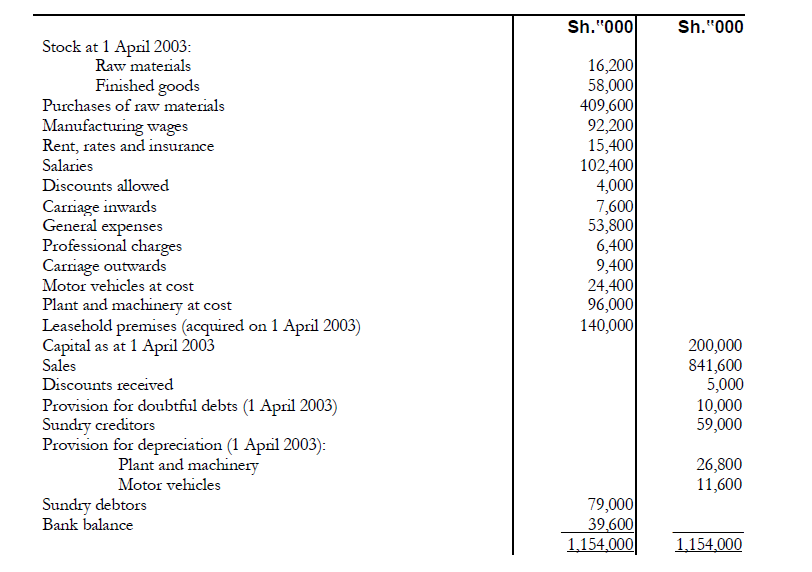
Additional information:
1. Sales included Sh.46,000,000 in respect of goods charged out to customers at cost plus
25% on a sale or return basis. The goods remained unsold as at 31 March 2004.
2. The stock of finished goods and raw materials at cost as at 31 March 2004 amounted to
Sh.63,600,000 and Sh.15,800,000 respectively.
3. Prepaid insurance as at 31 March 2004 was Sh.400,000 and Sh.1,000,000 was owing for
lighting and heating as at the same date. Lighting and heating is accounted for through
the general expense account.
4. Included in the salaries account were drawings by J.Kiarie amounting to Sh.400,000 per
week. (Assume a 52 – week year)
5. A debt of Sh. 1,000,000 is to be written off and provision for doubtful debts is to be
reduced to Sh.8,000,000
6. During the year, motor vehicles which had cost Sh.12,000,000 and which had been
written down to Sh.4,000,000 were sold for Sh.9,600,000. This amount has been
credited to motor vehicles account.
7. Legal fees amounting to Sh.2,800,000 in respect of acquisition of the leasehold premises
are included in the professional charges account. The lease costs are to be amortised
over 20 years.
8. Provision for depreciation on motor vehicles and plant and machinery is to be made at
Sh.3,800,000 and Sh.5,000,000 respectively.
Required:
(a) Manufacturing, trading and profit and loss accounts for the year ended 31 March 2004.
(b) Balance sheet as at 31 March 2004. (10 marks)
Date posted:
November 17, 2018
.
Answers (1)
-
Mali Mingi is the sole distribution agent of roofing sheets in Mombasa. Under an agreement
with the manufacturers, Mabati Ltd., Mali Mingi purchases roofing sheets from...
(Solved)
Mali Mingi is the sole distribution agent of roofing sheets in Mombasa. Under an agreement
with the manufacturers, Mabati Ltd., Mali Mingi purchases roofing sheets from Mabati Ltd. at a
trade discount of 20% of the list price. Every year in the month of May, Mali Mingi receives an
agency commission of 1% of his purchases for previous year ended 31 March.
Mali Mingi has been making a gross profit of 40% on all sales. In a burglary that occurred in
January 2004, Mali Mingi lost stock costing Sh.480,000 as well as the bulk of his accounting
records.
After thorough investigation, the accountant has obtained the following information relating to
the year ended 31 March 2004:
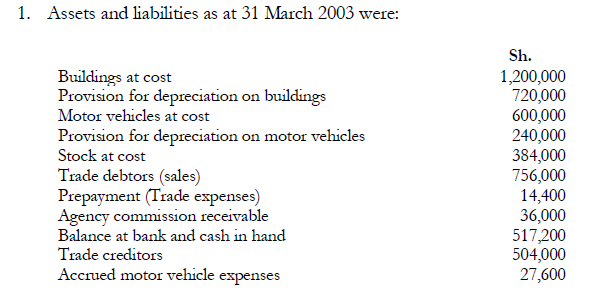
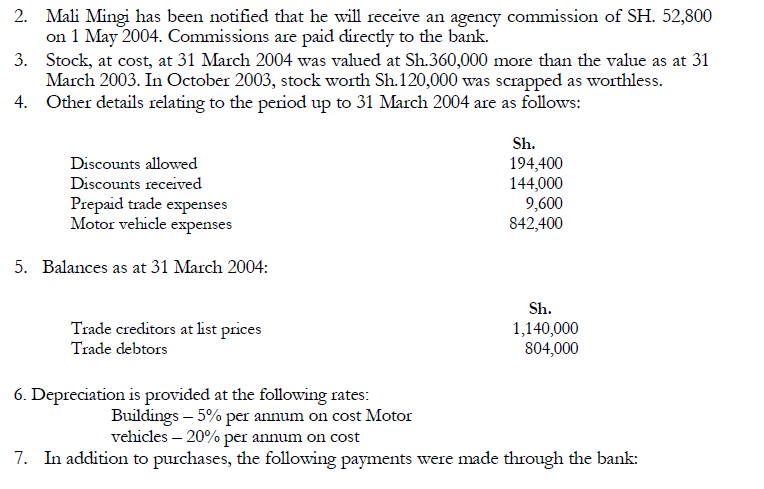
Motor vehicle expenses 806,400
Drawings 516,000
Trade expenses 883,200
8. All receipts pass through the bank and Mali Mingi is not insured against burglary.
9. The agency commission due as at 31 March 2003, was received during the year through
the bank.
10. All purchases and sales are on credit.
Required:
(a) Trading and profit and loss accounts for the year ended 31 March 2004.
(b) Balance sheet as at 31 March 2004.
Date posted:
November 17, 2018
.
Answers (1)
-
Briefly explain whether revenue may be recognized in the following circumstances in
respect of sales made by a business entity:
(i) Goods have acquired by the business...
(Solved)
Briefly explain whether revenue may be recognized in the following circumstances in
respect of sales made by a business entity:
(i) Goods have acquired by the business entity which it confidently expects to resell
very quickly
(ii) A customer places a firm order for goods
(iii) Goods are delivered to the customer‟s premises
(iv) The customer's cheque in payment for the goods has been cleared by the bank.
Date posted:
November 17, 2018
.
Answers (1)
-
Meza Ltd has an authorized share capital of Sh.20,000,000 divided into 1,500,000 ordinary shares of Sh.10 each and 250,000 8% preference shares of Sh.20 each.
An...
(Solved)
Meza Ltd has an authorized share capital of Sh.20,000,000 divided into 1,500,000 ordinary shares of Sh.10 each and 250,000 8% preference shares of Sh.20 each.
An extract of the balance sheet as at 30 June 2003 was as follows:

On 1 July 2003, the company offered 500,000 ordinary shares for sale to the public at Sh.15 each
payable as follows:
- On application Sh.7 including the premium
- On allotment Sh.5
- On first and final call, Sh.3
Applications were received on 15 July 2003 and allotment made on 31 July 2003. The allotment
money was received on 15 August 2003.
The first and final call was made on 15 September 2003 and the money received on 30
September 2003.
The company received applications for 650,000 shares. Applications for 25,000 shares were
rejected and the application money was refunded. The shares were then allocated to the
remaining applicants on a pro rata basis, the excess of the application money being carried
forward in part satisfaction of the amounts due on allotment.
An allotee of 3,000 shares failed to pay both the allotment and first and final call money and the
shares were forfeited on 13 October 2003.
The forfeited shares were then re-issued at Sh.12 each on 21 October 2003.
Required:
(a) Ledger accounts to record the above transactions
(b) Balance sheet as at 21 October 2003
Date posted:
November 17, 2018
.
Answers (1)
-
The following version of the receipts and payments account has been provided by the treasurer of Maendeleo Social club for the year ended 31 October...
(Solved)
The following version of the receipts and payments account has been provided by the treasurer of Maendeleo Social club for the year ended 31 October 2003:
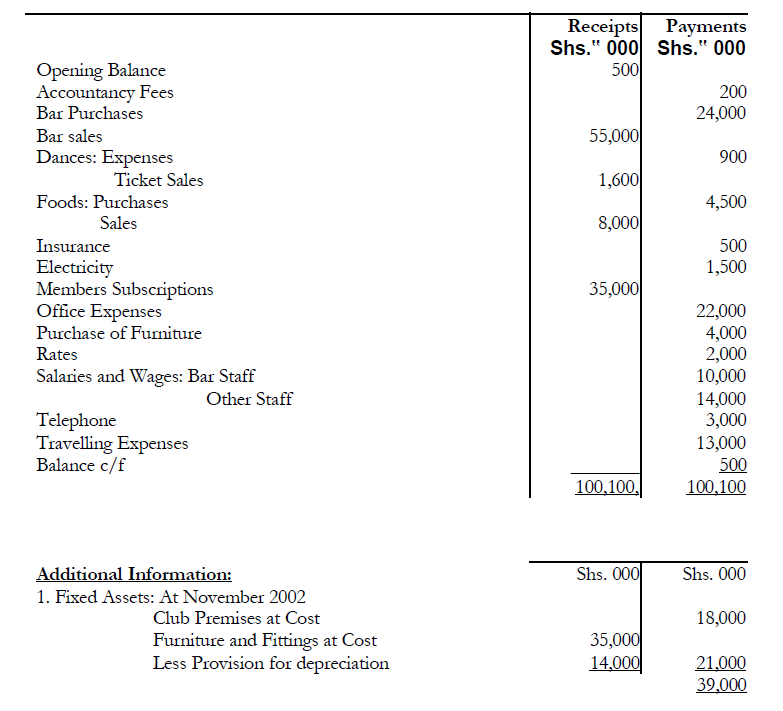
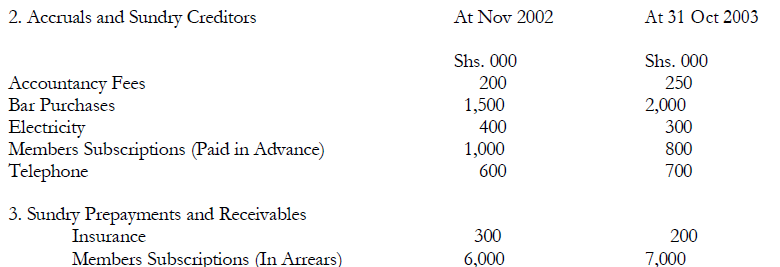
4. Maendeleo Social Club had a Bank Account, which had a balance of Shs. 2,500,000 on
1 Nov 2002. This Bank account was not used during the year to 31 Oct 2003and the
only entry made in this account was for the interest of shs. 200,000 which was credited
yo the bank on 31 Oct 2003.
5. Depreciation on Furniture and fittings is at the rate of 10% per annum on cost. A full
years depreciation is provided for any furniture bought during the year.
6. Bar stock was valued at shs. 7,000,000 0n 1 Nov 2002 and at Shs. 1,500,000 on 31
Oct 2003.
7. No Apportionment of costs is made between bar activities and other club activities.
Required:
i. Income and Expenditure Account for the year 31 Oct 2003.
ii. Balance Sheet
Date posted:
November 17, 2018
.
Answers (1)
-
The following are the summarized financial statements of Deweto limited
(Solved)
The following are the summarized financial statements of Deweto limited:
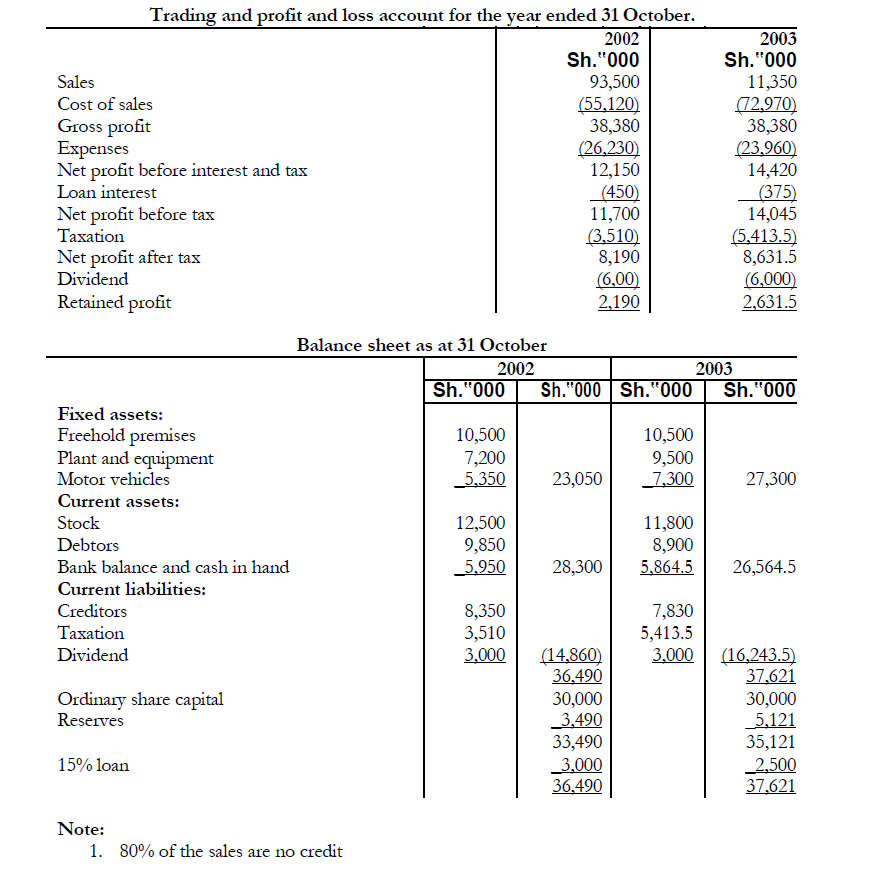
2. The stock as at 31 October 2001 was valued at Sh.13,000,000
Required:
(a) Calculate two ratios for each classification identified below for the financial years ended
31 October 2002 and 2003:
(i) Profitability ratios
(ii) Liquidity ratios
(iii) Gearing ratios
(iv) Activity ratios
(b) Comment on Deweto Ltd‟s profitability and liquidity positions.
Date posted:
November 17, 2018
.
Answers (1)
-
The following categories of people are recognized as users of the information
contained in financial statements:
- Owners.
- Financial analysts.
- Lenders.
For each of the above users of...
(Solved)
The following categories of people are recognized as users of the information
contained in financial statements:
- Owners.
- Financial analysts.
- Lenders.
For each of the above users of financial statements, identify the kind of information they
may require, why they require it and the decisions they make from that information.
Date posted:
November 17, 2018
.
Answers (1)
-
Briefly explain three circumstances under which “goodwill” can be recorded in a business firm's books of account
(Solved)
Briefly explain three circumstances under which “goodwill” can be recorded in a business firm's books of account.
Date posted:
November 17, 2018
.
Answers (1)
-
The following balances remained in the books of Ahadi Ltd. as at 30 April 2003 after the preparation of the trading account:
(Solved)
The following balances remained in the books of Ahadi Ltd. as at 30 April 2003 after the preparation of the trading account:
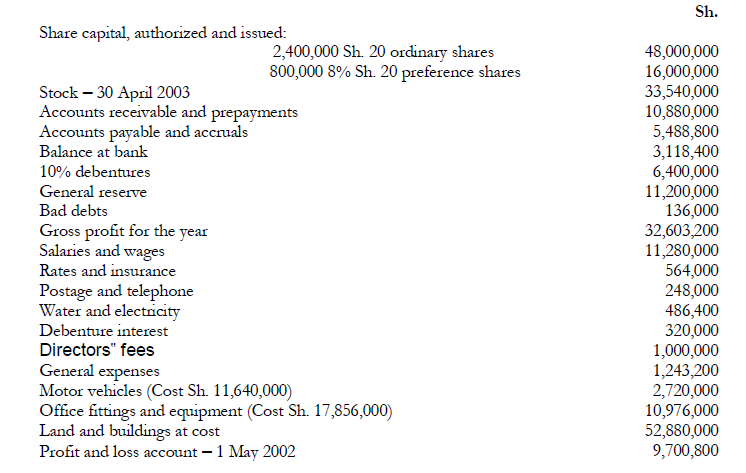
Additional information:
1. A bill for Sh. 219,200 in respect of electricity for the period up to 30 April 2003 has
not been accrued.
2. The amount for insurance includes a premium of Sh. 120,000 paid in January 2003
to cover the company for six months, February to July, 2003.
3. Office fittings and equipment are to be depreciated at 15% per annum on cost
and motor vehicles at 20% per annum on cost.
4. Provision is to be made for:
Directors‟ fees - Sh. 2,000,000
Audit fee - Sh. 480,000
The outstanding debenture interest.
5. The directors have recommended that:
- A sum of Sh. 4,800,000 be transferred to general reserve.
- The preference dividend be paid.
- A 10% ordinary dividend be paid.
Required:
(a) Profit and loss and appropriation accounts for the year ended 30 April 2003.
(b) Balance sheet as at 30 April 2003.
Date posted:
November 17, 2018
.
Answers (1)
-
You have recently been employed in a medium size company and deployed in the accounts department. Your head of section has given you the following...
(Solved)
You have recently been employed in a medium size company and deployed in the accounts department. Your head of section has given you the following extract from the cashbook for the month of April 2003.

The head of section further informs you that all receipts are banked intact and all payments are
made by cheque. On investigation, you discover the following:
1. Bank charges and commissions amounting to Sh. 272,000 entered on the bank
statement had not been entered in the cashbook.
2. Cheques drawn amounting to Sh. 534,000 had not been presented to the bank for
payment.
3. Cheques received totaling Sh. 1,524,000 had been entered in the cashbook and paid into
the bank, but had not been credited by the bank until May 2003.
4. A cheque for Sh. 44,000 had been entered as a receipt in the cashbook instead of a
payment.
5. A cheque for Sh. 50,000 had been debited by the bank by mistake.
6. A cheque received for Sh. 160,000 had been returned unpaid. No adjustment had been
made in the cashbook.
7. All dividends receivable are credited direct to the bank account. During the month of
April 2003. Dividends totaling Sh. 124,000 were credited by the bank and no entries had
been made in the cashbook.
8. A cheque drawn for Sh. 12,000 had been incorrectly entered in the cash book as Sh.
132,000.
9. The balance brought forward should have been Sh. 1,422,000.
10. The bank statement as at 30 April 2003 showed on overdraft of Sh. 2,324,000.
Required:
(i) The adjusted cashbook as at 30 April 2003.
(ii) Bank reconciliation statement as at 30 April 2003.
Date posted:
November 17, 2018
.
Answers (1)
-
Briefly explain why it is important for a business entity to prepare a bank reconciliation statement
(Solved)
Briefly explain why it is important for a business entity to prepare a bank reconciliation statement
Date posted:
November 17, 2018
.
Answers (1)
-
Differentiate between a petty cashbook and a three-column cashbook
(Solved)
Differentiate between a petty cashbook and a three-column cashbook.
Date posted:
November 17, 2018
.
Answers (1)
-
The following balances have been extracted from the books of Limuru Manufacturers, a small scale manufacturing enterprise, as at 31 December 2002:
(Solved)
The following balances have been extracted from the books of Limuru Manufacturers, a small scale manufacturing enterprise, as at 31 December 2002:
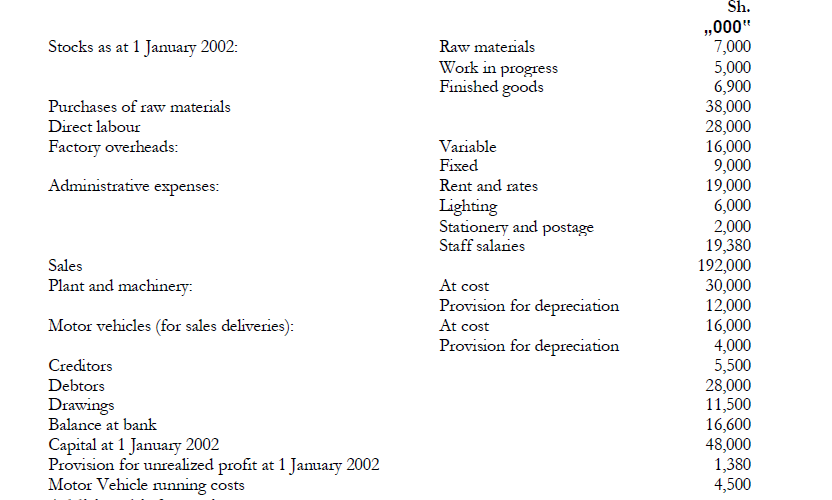

2. The factory output is transferred to the trading account at factory cost plus 25%
of factory profit.
3. Depreciation is provided at the rates shown below on the original cost of fixed
assets held at the end of each financial year.
Plant and machinery - 10% per annum
Motor vehicles - 25% per annum
4. Amounts accrued at 31 December 2002 for direct labour amounted to Sh. 3,000,000
and rent and rates prepaid at 31 December 2002 amounted to Sh. 2,000,000.
Required:
(a) Manufacturing, trading and profit and loss account for the year ended 31 December
2002.
(b) Balance sheet as at 31 December 2002.
Date posted:
November 17, 2018
.
Answers (1)
-
Denticare Limited makes its accounts on 30 June every year. On 1 July 2001, the company's balance sheet included the following figures for non -current...
(Solved)
Denticare Limited makes its accounts on 30 June every year. On 1 July 2001, the company's balance sheet included the following figures for non-current assets:

The company's policy is to charge depreciation at the following rates:

A proportionate charge is made in the year of purchase, sale or revaluation of an asset.
During the year ended 30 June 2002, the following transactions took place:
1. On 1 January 2002 the company decided to adopt a policy of revaluing its buildings. A
professional valuer engaged for this purpose revalued the buildings at Sh.34
million.
2. On 1 Janua ry a plant that had cost Sh.3 million was sold for Sh.500, 000. Accumulated
depreciation on this plant on 30 June2001 amounted to Sh.2.3 million. A new plant was
then purchased at a cost of Sh.4 million.
3. On 1 April 2002 a new motor vehicle was purchased for Sh.300, 000 Part of the
purchase price was settled by exchanging another motor vehicle at an agreed value of
sh.120, 000 The balance of Sh.180,000 was paid in cash. The vehicle which was given in
part exchange had cost Sh.200, 000 and had a net book value of Sh.100, 000 as at 30
June 2001
Required:
(a) The following ledger accounts to record the above transactions:
(i) Buildings account.
(ii) Provision for depreciation: Buildings.
(iii) Plant and machinery account.
(iv) Provision for depreciation: Plant and Machinery.
(v) Motor vehicles account.
(vi) Provision for depreciation: Motor vehicles.
(b) Property, plant and equipment movement schedule for the year ended 30 June 2002.
Date posted:
November 17, 2018
.
Answers (1)
-
Masaba Company Ltd. is a retail provider with an authorised share capital of 800,000 Sh.20 ordinary shares and 250,000 8% Sh.20 redeemable preference shares.
The following...
(Solved)
Masaba Company Ltd. is a retail provider with an authorised share capital of 800,000 Sh.20 ordinary shares and 250,000 8% Sh.20 redeemable preference shares.
The following financial information reflects the position of the company as at 31 December
2001 after preparing the Trading, profit and loss account:
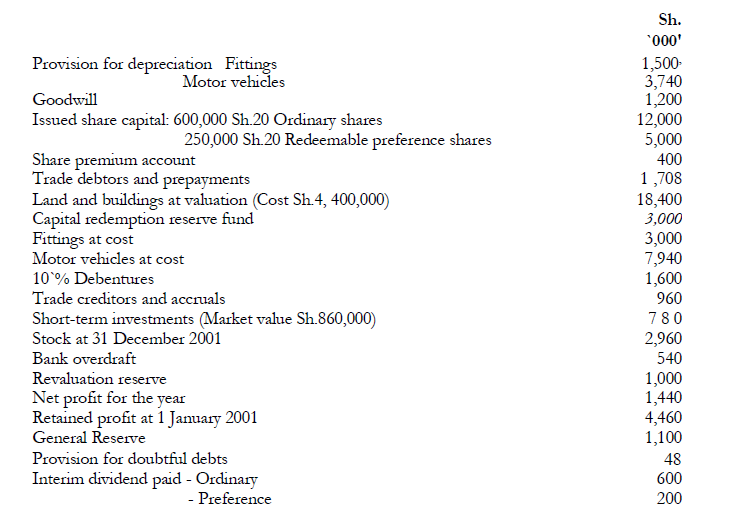
The following resolutions relating to year ended 31 December 2001 have been passed by the
board of directors of the company
1. Transfer Sh.500,000 to General Reserve.
2. Provide for 5% final dividend and final preference dividend on shares issued
and outstanding on 31 December 2001.
3. Make a bonus issue of 100,000 fully paid ordinary shares from the retained profits
account.
Required:
(i) The appropriations account of Masaba Company Ltd. for the year ended 31 December
2001.
(ii) The balance sheet of Masaba Company Ltd. as at 31 December 2001.
Date posted:
November 17, 2018
.
Answers (1)